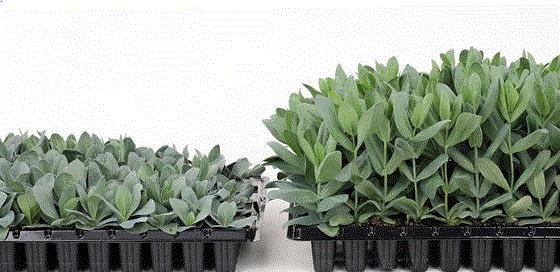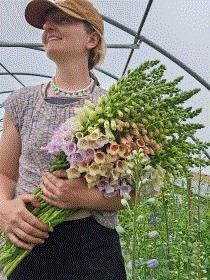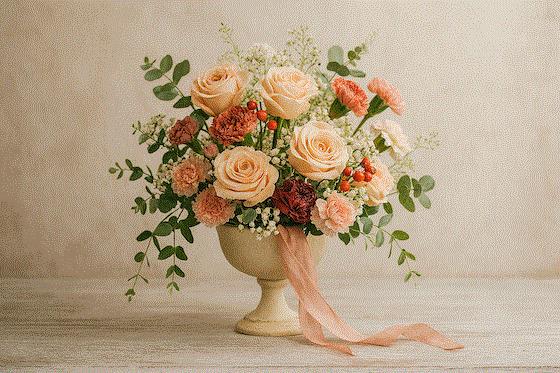August Farm Update
Welcome to the last leg of the summer marathon. August days feel the longest, even though the days are getting shorter. Probably because this summer has been a grind, even more so than other seasons. The summer season in Michigan started wet, and now we haven’t seen a drop of rain in ten days. Trust me, even a little sprinkle is welcomed about now. In the meantime, Tater and I are working extra hard to keep the flowers watered, harvested and free of pests.
The August to-do list is always long. We are already thinking about next spring, sowing anemone for Christmas and scrambling to harvest all the flowers in the field. It is nice seeing the anemone corms starting to sprout. The anemone remind me that cooler temperatures and longer nights are on the way. I always count down the weeks until September, because cooler temperatures make the flowers and the crew happier.
My favorite part about flower farming is that as soon as you are bored with one crop, it’s about time to start a new one. I enjoy the circadian rhythm of local flowers. We have an acre of outdoor dahlias this season. The field is getting ready to explode with blooms and all of our hard work this summer is going to pay off. But the stock, snapdragons, heirloom mums and anemone can’t come soon enough.
In this edition of Bloom Beat we’re talking about cool-season flowers (oh the irony!), AI flowers, burnout prevention tips and more!
With all that being said, let’s talk shop!

All About Lisianthus Rosette

Rosette-resistant plugs on the right. Both trays grown above 82F for the first four weeks. Photo by Sakata
Tater and lisianthus have a lot in common: They both are highly sought after, are incredibly beautiful ... and they both resent the heat!
If you have young lisianthus in production or you are trying to get a second flush from your first lisianthus succession, you’ll want to watch out for rosetting. What is rosetting? Plants that have stopped growing taller and only produce short leaves that overlap each other, with very short internotes. This leads to short stems, decreased flower quality and delays in production. Moisture stress and/or temperatures above 75F for an extended period can trigger rosetting.
From a biological perspective, the lisianthus use rosetting as a means of delaying flowering until growing conditions improve. Remember, plants flower to produce seed to pass their genes on to the next generation. Stressed plants go into survival mode (such as rosetting) to increase the probability of pollination, seed production, and the next generation of plants.
It's hard to get the plants out of dormancy once triggered, but if you buy prechilled lisianthus plugs this helps deactivate the rosetting gene. This is especially important since stressed lisianthus plugs might not start rosetting until after they are transplanted.
According to the experts at Sakata, you can use gibberellic acid at 50-100 ppm to combat rosetting. Check the plants two weeks after the first application of gibberellic acid. If the plants did not “bolt” (prematurely develop flowers) you can make a second application. Moral of the story: make sure your lisianthus don’t rosette in the first place, and buy precooled plugs.
Breeders are trying to breed the rosette gene out of lisianthus, but we’re still a ways away from that. But there are more resistant varieties. Check out this
VIDEO from our friends at Sakata to learn more.

Don't Forget About Cool-Season Flowers
I know we are all in the thick of peak flower season, but don’t forget to start thinking about your cool-flower crop plan.

The Dirt on Flowers had a great
PODCAST with Lisa Mason Ziggler (aka Cool Flower Queen) on planning for this. I am grateful for the timely reminder! Tater and I need to order feverfew, campanula, poppies, pansy, foxglove (photo on the right) and a few other things. Remember, spring is the highest demand season for flowers. A little diligence in August can pay tremendous dividends next spring.
I encourage you to give the podcast a listen. For instance, I learned that tweedia is considered a cool flower. I never knew that! It might be worth planting some in one of our minimally heated tunnels.
One of the key points Lisa hits on hard on is to prep your soil this fall. This will save you and your equipment from having to deal with frozen soil next winter.
If you are look for a starting point for cool flowers, Lisa has a compilation of cool-season flowers videos on her
BLOG and
YOUTUBE channel. She also has this great
Cool Flowers Cheat Sheet to help you craft your crop plan based on your hardiness zone.
I know it is a lot to juggle right now, but future you will be glad you took the time now to sow some extra plug trays for next spring.

Livestream: Pre-emergence Herbicides
Spend a Little, Save a Lot: How the timely use of pre-emergence herbicides can save you time and money
Date: Wednesday, August 27
Time: 1 p.m. Eastern/Noon Central
Our peony patch was a mess until this past week. Some of the weeds were twice as tall as Tater! Not my proudest farm moment, but in July and August we have a thousand different irons in the fire and sometimes the perennials we rely on during the early spring season succumb to neglect during the late summer months. We are starting to entertain the thought of incorporating preemergent herbicides into our crop plan, so I was pretty excited when Bossman Beytes sent me the email about the live stream seminar he's doing with the folks at Envu this month.
Most growers know that using pre-emergence herbicides can help reduce their overall hand weeding and spot spraying weed control costs. Envu recently sponsored a third-party study that looks at the actual costs, and savings, that you can expect from a comprehensive weed control program. The results show which products and practices offer the greatest return for your investment. The results also show this: Your greatest cost is the cost of neglect!

Bossman has two guest experts lined up for this webinar. Janna Beckerman, Ph.D., is the ornamentals technical specialist at Envu and part of their Green Services Team. Prior to Envu, she worked at Purdue University and the University of Minnesota as a professor of plant pathology and extension plant pathologist for 25 years.
Steve Larson, Greenhouse and Nursery Specialist for Envu, has worked as a grower and a technical sales rep in the turf & ornamental industry for more than 40 years. He has worked in container nursery production, greenhouse crop production, and technical sales while working for Hines Nurseries, The Scotts Company, BASF and Envu (formerly Bayer).
With Bossman Beytes as host and moderator, trust me, you are in for a good time! Tater and I look forward to learning more about pre-emergent herbicides. Hopefully we will “see” you there!

Beat Summer Burnout Before it Starts
Alright friends, here is Tater's annual PSA on combating summer burnout. Now is the time to keep tabs on yourself and to take extra good care of yourself. Buckle up!
Let me preface this by saying I am not a professional psychologist. But I can tell you as someone who grapples with burnout each season (especially in August), it is imperative to take care of yourself.
So what is burnout? According to Psychology Today, burnout is “a state of emotional, mental and often physical exhaustion brought on by prolonged or repeated stress.”
It is no surprise that many growers and farmers fall into the burnout trap. If you are feeling burned out, you are not alone. According to a
STUDY conducted with Canadian farmers, out of 1,000 participants, 44% were experiencing burnout at some level, which another 12% were categorized as burned out (but not self-identified as such).
I found this
ARTICLE from
Psychology Today that summarizes Dr. Christina Masiach from the University of California Berkeley on burnout. According to her research, burnout from work boils down to six things:
- Never-ending work load, and a to-do list that also never ends (sound familiar?)
- Feeling a lack of control in your circumstances or your superiors
- A work environment that is hostile or unfair
- Lack of community and camaraderie (personal or at the workplace)
- Work does not align with your values
- Work does not feel rewarding, no prestige or positive feedback
Granted, the above reasons may not all apply to you, but a handful of the scenarios may be a source for your burnout. I can personally say that in past seasons, the first two items have resonated with me.
In order to combat burnout, you need to understand what is causing it. Once you have identified the cause, ask yourself what would it take to be engaged with your farm and your flowers again? What comes to mind when you think about how you would like to spend your time on the farm? From there, work backwards and determine what actionable steps you can take to make that a reality. For instance, who can you hire or who on your crew can you delegate certain tasks to? Do you need to hire a specialist, such as a bookkeeper or marketing expert, to help free up your time?
I’ll be frank—I am just now getting out of the “I have to do everything myself” trap. Your emotional and moral compass should direct your steps; if you feel emotionally unfulfilled or your wellbeing cup is empty, it is important to change course sooner rather than later. Burnout not only affects you, but your loved ones, and your crops.
I have said it once, I will probably say it again: Farming is hard. Farming is demanding. So in order to prevent burnout you need to make a plan on how to take care of yourself. Here is what I found to be the best way to combat burnout:
First and foremost, you need to keep tabs on your physical wellbeing. Eat balanced meals (not just fast food), get a full night’s sleep, and exercise. I know this is all easier said than done during peak flower season, but I firmly believe that if your body suffers, so does your ability to farm. Your physical health and the health of your farm go hand and hand.
Second, try this mindfulness exercise:
- Make a list of all the things you enjoy doing outside of farming
- Make a list of things that get in the way of doing those things
- Share your plan with your loved ones—they will help keep you accountable
- Revise and adjust your original plan as needed
Being mindful of how you feel (physically and emotionally), and being aware of how you spend your time compared to how you want to spend it are keys to preventing burnout. Try the exercise Tater and I suggested above and
LET US KNOW what you think.

AI Flowers A Potential Threat?
 An AI-generated floral arrangement. New Bloom Media
An AI-generated floral arrangement. New Bloom Media
Tater and I stumbled upon this
ARTICLE on AI flowers. We’ve all seen AI-generated flower images all over social media. Do they pose a challenge to our industry? The authors at
New Bloom Media posed the question, “If AI-generated flowers already look this good, what happens when they get better?”
The more I ponder the question, the more it leads to more questions. Are AI-generated images giving consumers unrealistic expectations? AI images are too perfect, there are no variations in color or variations in petal size and presentation. AI also creates images of flowers that don’t exist, such as rainbow-colored hibiscus.
One possible challenge to AI flowers is educating clients on which flowers do exist. There are no dinner-plate-sized roses or true blue sunflowers at this point. But I think the good AI can do for our industry outweighs the bad. Our florist customers are using AI for wedding bouquet designs and can show a bride her ideas with just a few clicks (like the image at the top). This saves a lot of time and can ensure clients and florists are on the same page for their vision and color story on the big day.
Don’t get me wrong, there are some crazy, outlandish AI floral images circulating social media. But I think that, as an industry, we have the upper hand. AI florals simply don’t compare to the real thing. Flowers are more than just visual; they have other sensory components, such as texture and fragrance. Last I checked, AI can’t generate a scratch-and-sniff freesia or sweet pea images.
What are your thoughts on AI images? Are you using AI on your farm? Tater and I would love to hear from you.
DROP US A LINE!
We're Cheering For You!
Lindsay Daschner (and Tater)
Editor-at-Large—Bloom Beat
Owner—Forget-Me-Not Farms
This email was received by 6,242 of your fellow fresh-cut flower growers!
If you're interested in advertising in Bloom Beat, contact Kim Brown and she will hook you up!